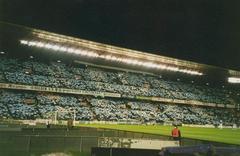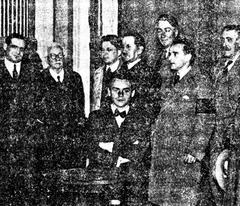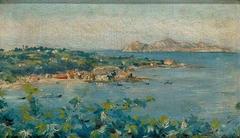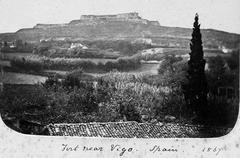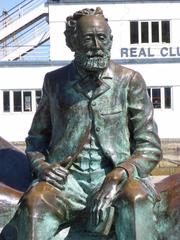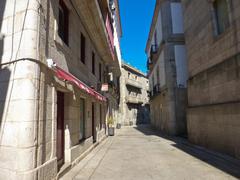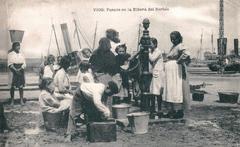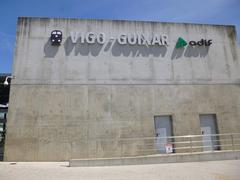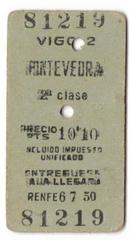
Casa de Fernando Carreras, Vigo, Spain: Visiting Hours, Tickets, and Historical Sites Guide
Date: 04/07/2025
Introduction
The Casa de Fernando Carreras, located at the intersection of Rúa Areal and Rúa Oporto in Vigo, Spain, is a hallmark of the city’s 19th-century urban expansion and architectural heritage. Commissioned by merchant Fernando Carreras and designed by Manuel de Uceda—an architect trained at Madrid’s Academia de San Fernando—this iconic building encapsulates Vigo’s transformation from a cluster of fishing villages into a cosmopolitan port city. Its story is woven into the city’s cultural fabric, having served as a private mansion, a bank, a military headquarters, and the seat of the University of Vigo’s Rectorate (es.wikipedia.org; myCityHunt).
This guide provides an in-depth look at the Casa’s architectural features, historical roles, visiting hours, ticket policies, accessibility, and tips for exploring nearby attractions.
Historical and Cultural Significance
The Origins and Architectural Commission
Casa de Fernando Carreras was conceived as a private residence for its namesake, a Vigo-born merchant who amassed his fortune abroad. The official project, signed in 1863 by Manuel de Uceda, marked the beginning of the city’s first major urban expansion, the “primer ensanche decimonónico.” Completed in 1865, the building was a physical manifestation of the aspirations of Vigo’s burgeoning bourgeoisie during an era of industrialization, economic growth, and urban modernization (es.wikipedia.org; galiciaguide.com).
Architectural Highlights
The Casa blends neoclassical motifs with Galician craftsmanship, most notably in its granite façade. Its symmetrical proportions, fluted pilasters, Corinthian and Ionic capitals, and decorative cornices exemplify mid-19th-century eclecticism. Individual balconies flank large semicircular-arched windows, while a continuous central balcony adds stateliness. Later additions, such as dormer windows, increased attic light and space. The building’s orientation at the intersection of Rúa Areal and Rúa Oporto was unique, predating changes in the street plan and reinforcing its prominence (turismodevigo.org; La Voz de Galicia).
Institutional and Civic Roles
Throughout its 160-year history, the Casa de Fernando Carreras has been repeatedly repurposed, reflecting the city’s evolving needs. Notably, it has served as:
- The first Banco de España branch in Vigo.
- Headquarters of the Gobierno Militar (Military Government) post-Civil War.
- Home to the Rectorate of the University of Vigo.
- Briefly, the mayoralty of Vigo in 2006, symbolizing civic renewal (myCityHunt).
Its adaptive reuse has preserved its structure and relevance, ensuring its status as a living monument within the city.
Practical Visitor Information
Location
- Address: Intersection of Rúa Areal and Rúa Oporto, central Vigo.
Visiting Hours
- Exterior Viewing: Accessible year-round, any time.
- Interior Access: Limited; generally available only during special events, cultural festivals, or scheduled guided tours.
- Special Open Days: Announced by the city or local tourism authorities—check Turismo de Vigo for updates.
Tickets
- Exterior: Free to view.
- Guided Tours: Ticket prices typically range from €3 to €20, depending on the provider and tour scope. Advanced booking is recommended for special openings.
Accessibility
- Exterior: Fully accessible via pedestrian-friendly streets; nearby bus stops and parking.
- Interior: Accessibility may be limited due to the building’s historic layout; contact local tourism offices for details (Ayuntamiento de Vigo).
Guided Tours and Events
- The Casa is a regular highlight of architectural and historical walking tours, often including the nearby Old Town, MARCO Museum, and waterfront.
- Some tours offer digital scavenger hunts and interactive experiences (myCityHunt).
Nearby Attractions
- Casco Vello (Old Town): Traditional Galician streets, plazas, and shops.
- MARCO Museum: Contemporary art exhibitions.
- Praia de Samil: Popular urban beach.
- Castrelos Park and Pazo de Castrelos: Gardens and manor house.
- Maritime Museum of Galicia: Explores Vigo’s seafaring history (Turismo de Vigo).
Visiting Tips
- Best Time to Visit: Spring and autumn for mild weather; July offers long, sunny days—book ahead due to peak tourism (Global Highlights).
- What to Wear: Light, breathable clothing; sun protection; comfortable shoes.
- Photography: The façade is best photographed in morning or late afternoon light.
- Dining: Enjoy local seafood and Galician wine at nearby restaurants.
Frequently Asked Questions (FAQ)
Q: Can I visit the interior of Casa de Fernando Carreras?
A: Generally, no; interior access is limited to special events or guided tours.
Q: Is there an entrance fee?
A: Exterior viewing is free; guided tours may have a fee.
Q: Are guided tours available?
A: Yes, book in advance via local tourism offices.
Q: Is it accessible for visitors with reduced mobility?
A: The exterior is accessible; interior accessibility is limited.
Q: Where can I get more information?
A: Visit the official Turismo de Vigo website or go to a city tourist information center.
Preservation and Community Value
Casa de Fernando Carreras is protected as a key piece of Vigo’s urban history. Preservation initiatives, including EU funding via FEDER, ensure its continued maintenance and adaptive reuse. The building remains a source of civic pride and a focal point for cultural memory, inspiring ongoing public debate about its future function (Ayuntamiento de Vigo).
Visuals and Interactive Media
High-quality images, virtual tours, and interactive maps are available on the official Vigo tourism website. Use keyword-rich alt text like “Casa de Fernando Carreras historic building in Vigo” for accessibility.
Interactive Map of Vigo Historical Sites
Travel and Visitor Tips
- Plan ahead: Book tours and accommodations early, especially in high season.
- Language: English is spoken in tourist zones, but learning basic Spanish or Galician is appreciated.
- Safety: Vigo is safe, but take standard precautions in crowded areas.
- Local Etiquette: Respect quiet in historic sites and avoid touching artifacts.
- Cash/Card: Bring both for small purchases and local market shopping.
Summary and Call to Action
Casa de Fernando Carreras stands as a testament to Vigo’s architectural sophistication and cultural evolution. Its neoclassical façade, enriched by Galician craftsmanship, and its layered civic history make it a must-see destination for travelers interested in history, architecture, and urban heritage. While its interior is only occasionally accessible, the building’s exterior, central location, and proximity to other attractions ensure a rewarding visit. For the most up-to-date information, guided tours, and exclusive content, download the Audiala mobile app and follow us on social media.
Further Reading and Official Sources
- Casa de Fernando Carreras - Wikipedia
- Casa de Fernando Carreras - myCityHunt
- Vigo’s Past and Present - Turismo de Vigo
- Historical Residence of Fernando Carreras - La Voz de Galicia
- Vigo Practical Information - Turismo de Vigo
- Official Ayuntamiento de Vigo Heritage Routes
- Spain Tourism - Vigo Destination
- Global Highlights: Spain Weather in July
- RunRunVigo
- Magma Sports



